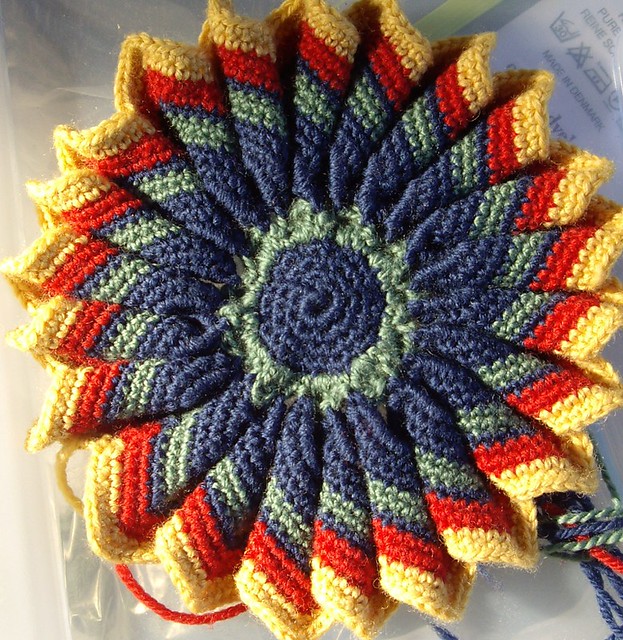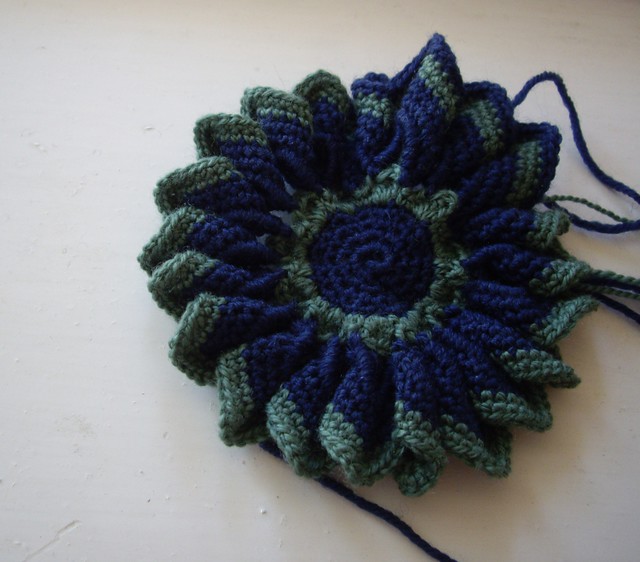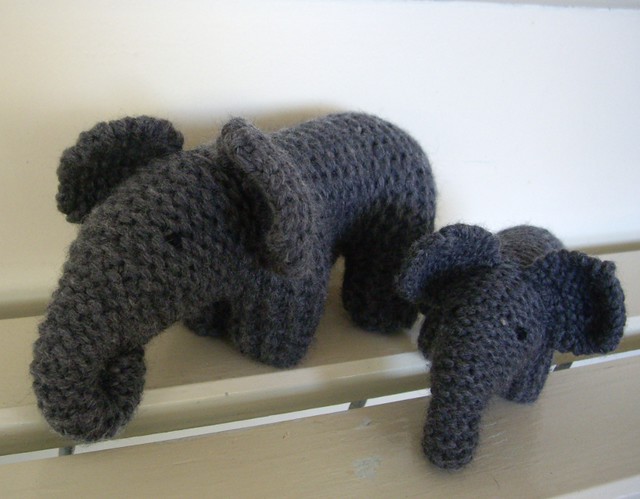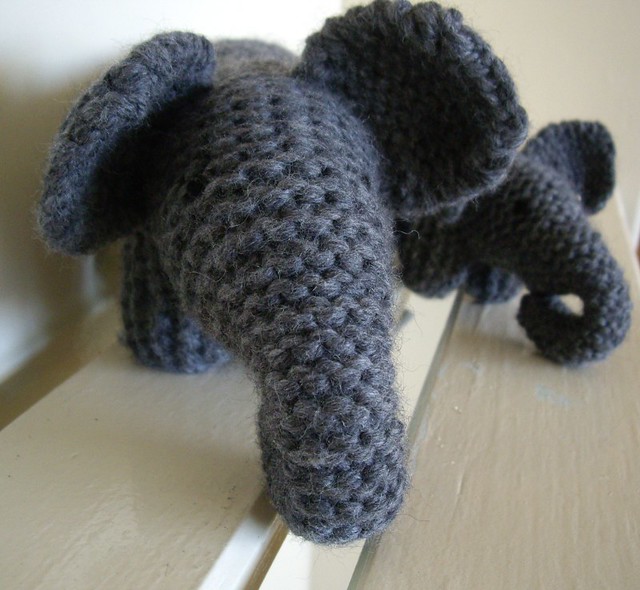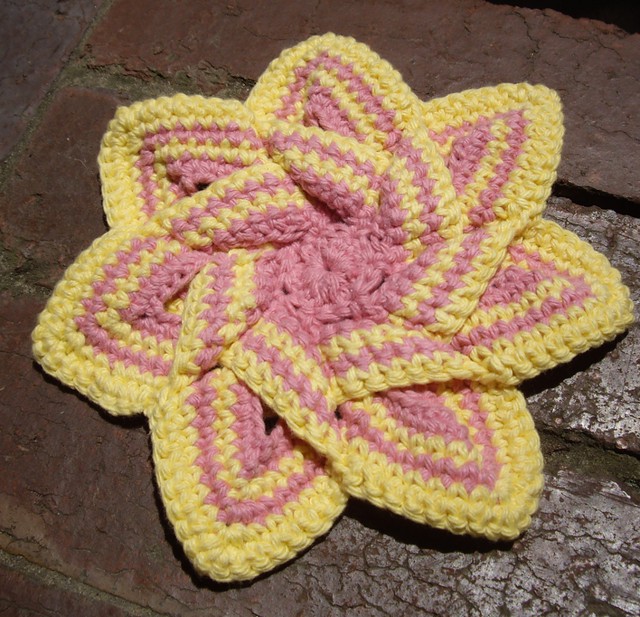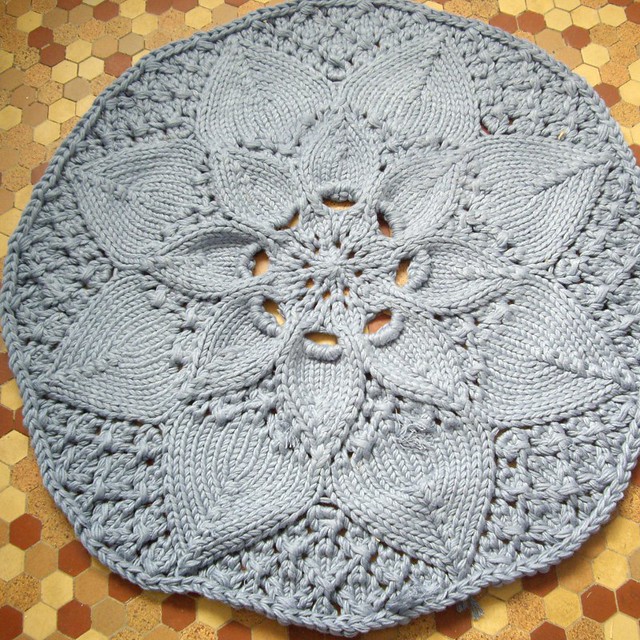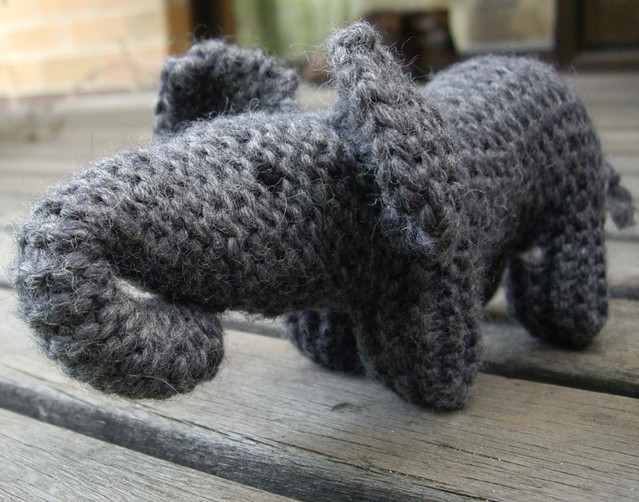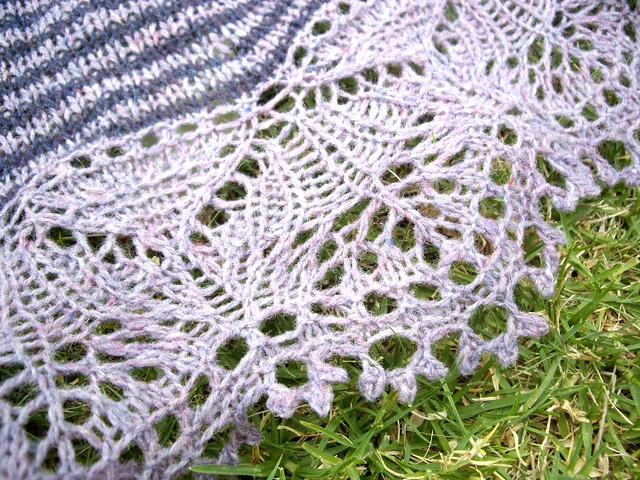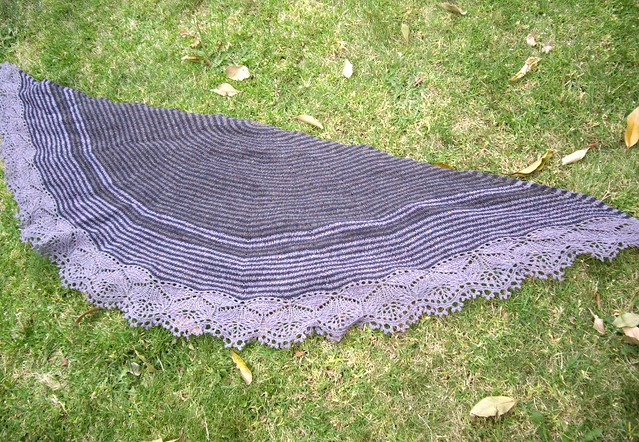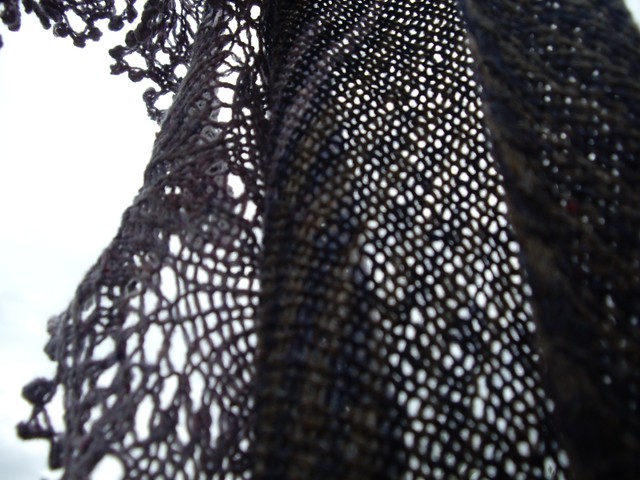Thursday, 31 January 2013
january reading
A Lion Among Men by Gregory Maguire - the third volume in the Wicked Years series, not my favourite so far but still a great read.
Does My Head Look Big in This? by Randa Abdel-Fattah - an entertaining and often amusing read, seems to be very biographical, about a sixteen-year old and aimed at a similar age group. Needed better editing as it was just that bit too long.
Tuesday, 29 January 2013
the magic flute
A change in tempo, have added some colourful notes:
There's some very fetching pale pink to follow then dark blue, light blue (with a texture change too) and then some more green. It's fun to see the colours coming together and the effect that each new stripe has on the whole (as it always is with colourwork) but really, I would like it to be over already.
Am also thinking about what I might like to do in the centre there - I don't much like that flat dark blue disk effect. It might be fun to crochet a covered button in one of the brighter colours and affix that in the centre.
There's some very fetching pale pink to follow then dark blue, light blue (with a texture change too) and then some more green. It's fun to see the colours coming together and the effect that each new stripe has on the whole (as it always is with colourwork) but really, I would like it to be over already.
Am also thinking about what I might like to do in the centre there - I don't much like that flat dark blue disk effect. It might be fun to crochet a covered button in one of the brighter colours and affix that in the centre.
Friday, 25 January 2013
i hear a flamingo fluting *
My knitting/crocheting is all over the place at the moment. I am desperate to finish something, just anything, so I keep casting on small (and not so small) projects, looking for quick satisfaction. Which is, of course, not forthcoming as everything gets stalled, or I get distracted or ... what was I talking about?
This is the beginning of the Pretty Fluted Cushion in Crochet by Madame Weigel. It's a vintage pattern and certainly doesn't make sense on row 4 and the colour progression in the illustration doesn't match that in the pattern and that lovely fluted effect is the result of there already being 252 stitches on the very first row of the vandykes (as they are referred to; that is, each spiky petal). Fortunately, the stitch count doesn't increase for some 16 rows and then by not much but that gentle progression from a few cast-on stitches to many hundreds is certainly missing. And the whole thing is done in double crochet (single crochet in the New World), not treble (translate: double crochet) as I thought so it's pretty laborious hooking. Anyway, I've since done another row of dark blue and one of red and it's looking simply smashing if I may say so myself. Is that suitable 1930s terminology?
(And it's using up a lot of stash yarn in which dear Babette, bless her heart, barely made a dint.)
* fluting in my ear - we love the Bill Martin Jnr/Eric Carle collaborations.
Wednesday, 23 January 2013
family portrait
Mother and baby, reunited!
Exactly the same pattern but mama was knit with two strands held together of Moda Vera Husky and baby Pachelbel just the one.
Exactly the same pattern but mama was knit with two strands held together of Moda Vera Husky and baby Pachelbel just the one.
Thursday, 17 January 2013
solar flare
It's been sunny here lately.
The Vital Statistics
Pattern: Crochet Flower Hot Pad by FreeCraft Unlimited, free (thank you!).
Size: One size.
Yarn: Sugar'n Cream Solids & Denim by Lily (100 per cent cotton), colours 1109 (yellow) and 18046 (rose pink); about 0.15 of a skein each.
Crochet hook: 4mm.
Start to finish: 9 January to 11 January 2013.
Stash/recycle content: Yes, from stash. I have blue somewhere too that I would have preferred to use with the yellow but no matter.
Comments: This was a case of 'new house, need new crochet hot pad', actually, just need crochet hot pad altogether. This sits on top of the oven and is the resting place for my Michael Graves designer kettle. The incongruity of this does not escape me. This is a well written pattern, fun to crochet and can actually look quite chic and graphic in one solid colour with a contrasting trim.
Verdict: I wonder if Alessi would consider doing them in black and white? black and grey? grey and white?
Sunday, 13 January 2013
monster doily from the deep
Ok, we're halfway through January and I feel as though I am catching up with myself a bit. So, a huge chunk of 2012 for us was taken up with moving - moving house, moving country, moving time zone - and that took up a lot of mental space and time and effort.
We are now nicely settled in a rental property in Hampton East in Melbourne and the decorating challenge is just how much homemade stuff is required, possible or appropriate. Hence the bathmats.
The Vital Statistics
Pattern: Liz Snella's Heirloom Doily by Vintage from Yarn Over free (thank you!)
Size: Just the one size and mine ended up huge, 60cm (23.5") across. I omitted the loopy crochet cast off.
Yarn: This time I used Moda Vera Bamboo/Cotton (70 per cent bamboo, 30 per cent cotton) in colourway indigo; 7.5 skeins.
Needles: 7mm.
Start to finish: 24 December 2012 to 7 January 2013.
Stash/recycle content: No.
Comments: I knit this with 4 strands held together (and again, way too small needles for the job to get a dense fabric). Knitting a doily pattern as a bathmat is a great reason to do some very textural lace. I was a little concerned that the bamboo/cotton mix might be too slippery on the floor but it's fine (speaking of which, our house has the original bathroom and it's fabulous - the original floor tile, pink bath and blue tiles with some burgundy accents on there and round windows in the doors. It's awesome.)
I should perhaps have cast off purlwise (instead of knitwise) but there's no way that I'm wrestling with this knitting again - it was unwieldy - and while I was working on it, the love just wasn't there. And the ends could have been better dealtwith. Getting it off the needles was a pleasant surprise because ...
Verdict: I'm very happy with it.
We are now nicely settled in a rental property in Hampton East in Melbourne and the decorating challenge is just how much homemade stuff is required, possible or appropriate. Hence the bathmats.
The Vital Statistics
Pattern: Liz Snella's Heirloom Doily by Vintage from Yarn Over free (thank you!)
Size: Just the one size and mine ended up huge, 60cm (23.5") across. I omitted the loopy crochet cast off.
Yarn: This time I used Moda Vera Bamboo/Cotton (70 per cent bamboo, 30 per cent cotton) in colourway indigo; 7.5 skeins.
Needles: 7mm.
Start to finish: 24 December 2012 to 7 January 2013.
Stash/recycle content: No.
Comments: I knit this with 4 strands held together (and again, way too small needles for the job to get a dense fabric). Knitting a doily pattern as a bathmat is a great reason to do some very textural lace. I was a little concerned that the bamboo/cotton mix might be too slippery on the floor but it's fine (speaking of which, our house has the original bathroom and it's fabulous - the original floor tile, pink bath and blue tiles with some burgundy accents on there and round windows in the doors. It's awesome.)
I should perhaps have cast off purlwise (instead of knitwise) but there's no way that I'm wrestling with this knitting again - it was unwieldy - and while I was working on it, the love just wasn't there. And the ends could have been better dealtwith. Getting it off the needles was a pleasant surprise because ...
Verdict: I'm very happy with it.
Saturday, 12 January 2013
pachelbel
I love the name Pachelbel but it's not one you get to use often, unless you're a music buff naming a toy pachiderm.
The Vital Statistics
Pattern: Elephant by Bonnie Gosse and Jill Allerton from the great first knitting book, aptly named A First Book of Knitting for Children.
Size: The pattern only provides for one size so it depends on what weight yarn you use.
Yarn: Moda Vera Husky (100 per cent baby alpaca) in colourway 5 'dark grey'; 1 skein.
Needles: It's a bulky yarn but I knit it with 2.75mm needles to get a really solid fabric so that the stuffing wouldn't show or leak through.
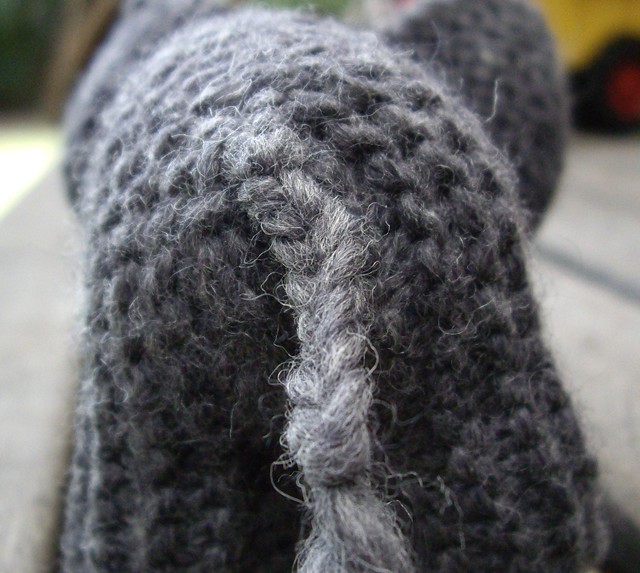 Start to finish: 15 December to 23 December 2012.
Start to finish: 15 December to 23 December 2012.Stash/recycle content: Alas, no. Oh actually, a tiny little bit. The embroidery wool for the eyes was bought at the op shop!
Comments: I actually knit two elephants, this baby one and a larger one using two strands at once and a 4mm needle. Unfortunately, I was so excited with the finished product that I gave it away to the happy recipient without even taking a photo. I'll try to get one at a later date.
I knit only 12 rows for head and decreased 1 st at beg of the last 2 rows for the ears. I then sewed the ears on with tail of the cast on, starting at the side of the body and working up toward the crown of the head. Then I used from the cast off end to gather up the side of the ear. Both elephants were stuffed with wool roving.
Verdict: Adorable, but certainly hard on the hands to knit.
Thursday, 10 January 2013
chunky crochet
One of these is still catching up with 2012, the other I just completed today.
The Vital Statistics
Pattern: By your bed/Bathmat/Doormat Rug - Free Crochet Pattern
by Ooty Yaacobi
and
African Flower Hexagon Crochet Tutorial by Heidi Bears.
Size: One size; the bathmat you could make larger by working extra rounds.
Yarn: Moda Vera Beetle (50 per cent cotton, 50 per cent acrylic) in a particularly unpleasant shade of pink, eight strands held together, used five skeins; and off-white recycled cotton/acrylic, 2 strands held together.
Hook: 15mm and 10mm, respectively.
Start to finish: 16 December to 23 December 2012; 9 January to 10 January 2013.
Stash/recycle content: The African Flower motif was made from yarn recycled from a Perry Ellis sweater that I bought at Sacred Heart Mission Op Shop for $5.
Comments: I decided that we needed some bathmats, and because it's quick, I opted to try a couple out in crochet, and in a cotton/acrylic mix because I thought that it would dry and wear better. These are two free patterns so the quality of the instruction is a bit uneven. The Ooty pattern is not very sophisticated (doesn't include instructions for turning chains) and the African Flower pattern goes into so much (extraneous) detail that it's almost confusing (clearly for absolute beginner or very nervous crocheter).
Verdict: Not great successes. The pink one has already met its demise (rubbish bin; couldn't stand the colour and shouldn't have worked with it in the first place but it was the best of a poor selection) and I will probably unravel the off-white motif in order to knit with it instead. There are many gorgeous examples of the African Flower motif out there, I think that doing it in an assortment of colours really helps.
Both projects were reasonably quick to make but the actual mechanics of working with such bulky yarn doesn't make for an enjoyable crafting experience and there's just not enough definition in chunky crochet (or maybe it's the cotton/acrylic mix). Won't be trying this again.
Sunday, 6 January 2013
time warp
I've decided to put the new year off until next month. Is that ok?
So, to round the year out with something familiar:
The Vital Statistics
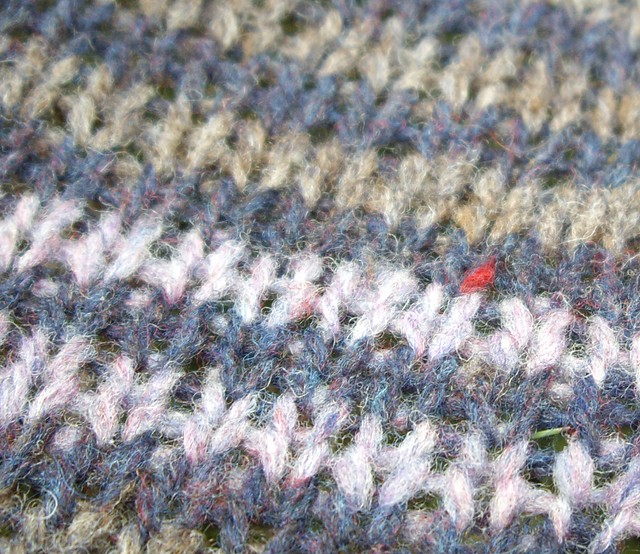
Yarn: Brooklyn Tweed Loft in 'truffle hunt' (my absolute favourite), 'old world' and 'blanket fort'. I love that one speck of red in the 'old world'.
Needles: 4mm.
Start to finish: 27 June to 19 December 2012.
Recycle/stash content: Well, it's all recycled from the first Cladonia that I knit but I don't think that really counts ...
Comments: I made considerable changes to this pattern to achieve a shawl that was both deeper and larger (that is, just more surface area altogether). The increase in depth was achieved by making the body increases every sixth instead of every fourth row. If you are making a striped version, this means that the increase will occur on alternating main colour and contrast colour rows (whereas in the regular version the increases are always on a main colour row). These increases all occur on right side rows.
To also make the shawl larger you need to effectively add some segments to the shawl (pattern provides for eight segments, mine has ten and I've seen that some people have increased it to eleven). To achieve the two extra segments, I made twice as many edge increases, half of which occur on wrong side rows; that is, you increase every sixth row for depth but every third at the edge. result is that the first and last of the eight segments are double the size (making effectively 10 segments) and the finished shawl thus four lace repeats wider along the border.
You can see here the elongated first and last segments and overall altered shape here (and that we don't much bother to rake up our leaves):
In order to make these two changes, you also need to make some changes when you cast on. To make the shawl wider/larger, you need to have 2 extra set-up stitches. Knit garter tab as per instructions (10 stitches on the needles: 3 for the garter stitch edge, 4 for the body of the shawl, 3 for the garter stitch edge); then work kfbf into first and last of the shawl body stitches (instead of just kfb) and kfb into the 2 intervening stitches (16 stitches on needles instead of 14).
Lastly, on this version I didn't do the contrast colour row in the edging; didn't feel that it was necessary now that I got the colours in better balance.
Verdict: I think that this is going to work for me now. I am delighted with the finished product and just need to wait for some cooler weather, or stand in the shade.
So, to round the year out with something familiar:
The Vital Statistics
Pattern: Cladonia by Kristen Kapur of Through the Loops. Wonderful, gorgeous shawl.
Size: The pattern only comes in one size but I increased the size and depth of mine - details below.
Yarn: Brooklyn Tweed Loft in 'truffle hunt' (my absolute favourite), 'old world' and 'blanket fort'. I love that one speck of red in the 'old world'.
Needles: 4mm.
Start to finish: 27 June to 19 December 2012.
Recycle/stash content: Well, it's all recycled from the first Cladonia that I knit but I don't think that really counts ...
Comments: I made considerable changes to this pattern to achieve a shawl that was both deeper and larger (that is, just more surface area altogether). The increase in depth was achieved by making the body increases every sixth instead of every fourth row. If you are making a striped version, this means that the increase will occur on alternating main colour and contrast colour rows (whereas in the regular version the increases are always on a main colour row). These increases all occur on right side rows.
To also make the shawl larger you need to effectively add some segments to the shawl (pattern provides for eight segments, mine has ten and I've seen that some people have increased it to eleven). To achieve the two extra segments, I made twice as many edge increases, half of which occur on wrong side rows; that is, you increase every sixth row for depth but every third at the edge. result is that the first and last of the eight segments are double the size (making effectively 10 segments) and the finished shawl thus four lace repeats wider along the border.
You can see here the elongated first and last segments and overall altered shape here (and that we don't much bother to rake up our leaves):
In order to make these two changes, you also need to make some changes when you cast on. To make the shawl wider/larger, you need to have 2 extra set-up stitches. Knit garter tab as per instructions (10 stitches on the needles: 3 for the garter stitch edge, 4 for the body of the shawl, 3 for the garter stitch edge); then work kfbf into first and last of the shawl body stitches (instead of just kfb) and kfb into the 2 intervening stitches (16 stitches on needles instead of 14).
Lastly, on this version I didn't do the contrast colour row in the edging; didn't feel that it was necessary now that I got the colours in better balance.
Verdict: I think that this is going to work for me now. I am delighted with the finished product and just need to wait for some cooler weather, or stand in the shade.
Subscribe to:
Comments (Atom)



